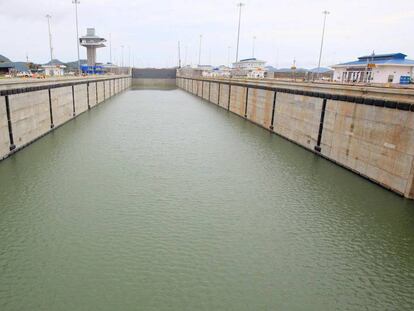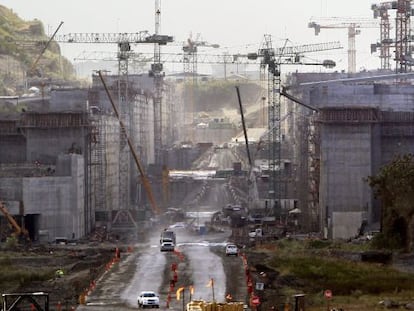Panama celebrates newly expanded canal as a patriotic milestone
The government put its dispute with Spanish-led consortium on hold to commemorate the completion of the troubled project

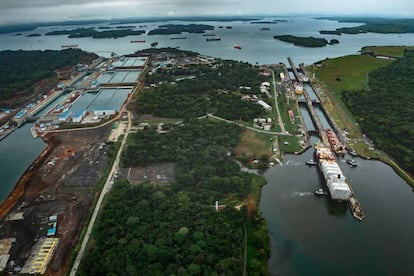
Sunday saw Panama unveil its newly expanded canal, the biggest engineering feat of the 21st century so far. A third wider lane connected to the other two paths will allow ships three times bigger to sail through. But the construction project has been plagued by controversy: construction finished 20 months late, unexpected costs led to a nearly $5.3 billion (€4.8 billion) price tag and resulted in a dispute between the consortium charged with building the project, headed by Spanish construction firm Sacyr, and the Panama Canal Authority.
But on Sunday, Panama put the conflict on hold to present its new project to the world. The government hopes the expansion will triple revenue. “The satisfaction of seeing the work finished leaves such a great taste in your mouth that you forget all the difficulties,” says Jorge Luis Quijano, the project’s administrator. This respite from the dispute does not seem to have damaged the Spain brand, thanks to the many Spanish companies now operating in the country and which are recognized for their technical competence.
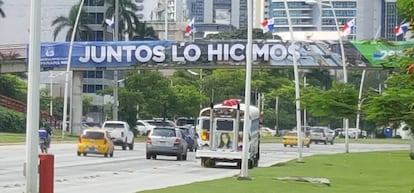
“When the United States opened the Panama Canal in 1914, only a few Panamanians took part in that milestone. More than 100 years later, the story has changed. About 95 percent of the 40,000 people who contributed their talent to make the wider canal a reality are Panamanians,” President Juan Carlos Varela said. The expansion will double the capacity of a canal that handles 5% of world trade. Varela also spoke about the eight workers who died during construction, a small number compared to the thousands of Panamanians who perished during the building of the original canal due to yellow fever, malaria and hard labor.
Besides the added economic power the expansion brings, the canal is also a source of patriotic pride for Panama. Its opening was an opportunity to remember the past and reaffirm its sovereignty as a nation. The symbol that brought the country international attention has finally stopped being a painful heritage from the years when it was little more than an American colony. The canal, which Panama regained in 2000, now bears the signature of Panamanian engineers and technicians.
A lottery for attendees
More than 10,000 Panamanians crowded around the Cocolí locks on the Pacific Ocean where the opening ceremony took place. Attendees were selected in a lottery and given non-transferable tickets. The ship that would be the first to officially cross the new channel was also chosen through a lottery (though several test boats made the journey before).
At 6am local time on Sunday, Cosco Shipping Panamá, a new container ship that belongs to the Chinese shipping company Cosco, passed through the new locks at Agua Clara on the Atlantic Ocean. Then, the captain of the ship disembarked to accept a commemorative gold and silver coin from President Varela and administrator Quijano. The ship was lifted 27 meters above sea level, crossed the semi-artificial lake Gatún and Culebra Cut before sailing through the Cocolí locks on the Pacific Ocean after a nine-hour journey.
Government officials, 2,400 guests from 62 international delegations including several heads of state such as Tsai Ing-wen (Taiwan), Michelle Bachelet (Chile), Luis Guillermo Solís (Costa Rica), Daniel Medina (Dominican Republic), Juan Orlando Hernández (Honduras), and Horacio Cartes (Paraguay) were waiting on the other side. Former Spanish King Juan Carlos I represented Spain at the event. That the United States was represented by members of its diplomatic corps and not by high-ranking officials raised some eyebrows. Even Jimmy Carter, the American president who signed the 1977 treaty that returned control of the canal to Panama in 2000, was absent.

“Together we did it” was plastered on large posters hanging all around Panama City. After nine years of construction, the expanded canal will revitalize the economy which, until last year, was the fastest-growing in the region. By opening a new lane to accommodate larger ships – the “neo-Panamax” vessels that can carry 13,000 containers – and offering a 65% discount on tolls, Panama is hoping to win back clients it lost to the Suez Canal.
And so Panamanian authorities prefer to move on from their dispute with the construction consortium that includes Sacyr, Salini Impregilo from Italy, Jan de Nu from Belgium and the Panamanian firm Cusa. The group won a $3.1 billion deal but they are now claiming an extra $3.5 billion in unexpected costs.
“Relations with Sacyr are good. We had a conflict but we sat down to negotiate and construction resumed. The differences they claim are being looked at by the appropriate authorities and in international arbitration. They will be resolved by 2018 at the latest,” explained Ilya Marotta, Panama Canal Authority president and the visible face of the project – so much so she has become a media star in her country.
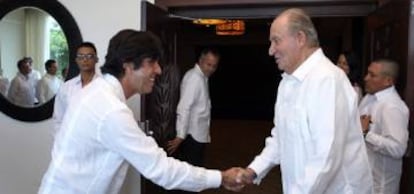
“The canal is finished now. We are going to keep working with Sacyr because, for example, we have a 10-year warranty for latent defects. I don’t think it will affect the image of the Spanish companies, and proof of that is the fact that they are doing several projects with Panama Metro,” Marotta adds.
“For Sacyr, this project is a great success because we have been able to overcome all the enormous challenges of every kind that we have run into,” Sacyr president Manuel Manrique says in an email. “We have shown the highest level of Spanish engineering since, besides Sacyr, 74 other companies also collaborated. I am sure that the success of this project, where output is better than what was stipulated in the contract, will open new opportunities for us all over the world.”
English version by Dyane Jean François.
Tu suscripción se está usando en otro dispositivo
¿Quieres añadir otro usuario a tu suscripción?
Si continúas leyendo en este dispositivo, no se podrá leer en el otro.
FlechaTu suscripción se está usando en otro dispositivo y solo puedes acceder a EL PAÍS desde un dispositivo a la vez.
Si quieres compartir tu cuenta, cambia tu suscripción a la modalidad Premium, así podrás añadir otro usuario. Cada uno accederá con su propia cuenta de email, lo que os permitirá personalizar vuestra experiencia en EL PAÍS.
¿Tienes una suscripción de empresa? Accede aquí para contratar más cuentas.
En el caso de no saber quién está usando tu cuenta, te recomendamos cambiar tu contraseña aquí.
Si decides continuar compartiendo tu cuenta, este mensaje se mostrará en tu dispositivo y en el de la otra persona que está usando tu cuenta de forma indefinida, afectando a tu experiencia de lectura. Puedes consultar aquí los términos y condiciones de la suscripción digital.
More information
Archived In
Últimas noticias
Most viewed
- Alain Aspect, Nobel laureate in physics: ‘Einstein was so smart that he would have had to recognize quantum entanglement’
- Mexico’s missing people crisis casts a shadow over World Cup venue
- Why oil has been at the center of Venezuela-US conflicts for decades
- Trump clarifies who is ultimately in charge in Venezuela: ‘Me’
- Mexico seeks to shore up its defenses following US incursion in Venezuela
